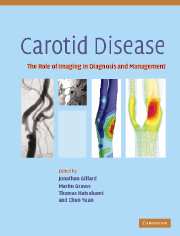Book contents
- Frontmatter
- Contents
- List of contributors
- List of abbreviations
- Introduction
- Background
- Luminal imaging techniques
- 9 Conventional carotid Doppler ultrasound
- 10 Conventional digital subtraction angiography for carotid disease
- 11 Magnetic resonance angiography of the carotid artery
- 12 Computed tomographic angiography of carotid artery stenosis
- 13 Cost-effectiveness analysis for carotid imaging
- Morphological plaque imaging
- Functional plaque imaging
- Plaque modelling
- Monitoring the local and distal effects of carotid interventions
- Monitoring pharmaceutical interventions
- Future directions in carotid plaque imaging
- Index
- References
9 - Conventional carotid Doppler ultrasound
from Luminal imaging techniques
Published online by Cambridge University Press: 03 December 2009
- Frontmatter
- Contents
- List of contributors
- List of abbreviations
- Introduction
- Background
- Luminal imaging techniques
- 9 Conventional carotid Doppler ultrasound
- 10 Conventional digital subtraction angiography for carotid disease
- 11 Magnetic resonance angiography of the carotid artery
- 12 Computed tomographic angiography of carotid artery stenosis
- 13 Cost-effectiveness analysis for carotid imaging
- Morphological plaque imaging
- Functional plaque imaging
- Plaque modelling
- Monitoring the local and distal effects of carotid interventions
- Monitoring pharmaceutical interventions
- Future directions in carotid plaque imaging
- Index
- References
Summary
Introduction
This chapter provides an overview of the traditional and evolving criteria used for grading carotid artery stenosis as well as the clinical relevance of sonography in the management of symptomatic and asymptomatic carotid disease. Additionally, discussions of carotid restenosis after endarterectomy as well as the diagnostic difficulties imposed by internal carotid coils and kinks, bilateral high-grade carotid stenosis and carotid stenting are included.
Technical points
Brachial systolic and diastolic blood pressures are measured in each arm. The carotid duplex ultrasound examination includes the carotid and vertebral arteries bilaterally, as stipulated by vascular laboratory accrediting organizations. Because the flow characteristics in one carotid artery may be influenced significantly by the status of the contralateral carotid artery, it is important to perform bilateral carotid examinations. A very high-grade stenosis or occlusion of one common or internal carotid artery can result in increased compensatory flow in the opposite vessel (Fujitani et al., 1992). The velocity readings in the patent artery therefore are higher than expected and may suggest a greater degree of stenosis than is actually present.
The ultrasound examination should include both longitudinal and transverse views of the vessels. Vessel diameter measurements, visual assessment of stenosis severity, and plaque assessments should be done in the transverse plane. Doppler waveforms should be generated from the longitudinal plane. Gray-scale images alert the examiner to the presence of plaque in the arterial wall, while changes in the hue of the color flow pattern suggest the presence of stenosis.
- Type
- Chapter
- Information
- Carotid DiseaseThe Role of Imaging in Diagnosis and Management, pp. 105 - 125Publisher: Cambridge University PressPrint publication year: 2006



